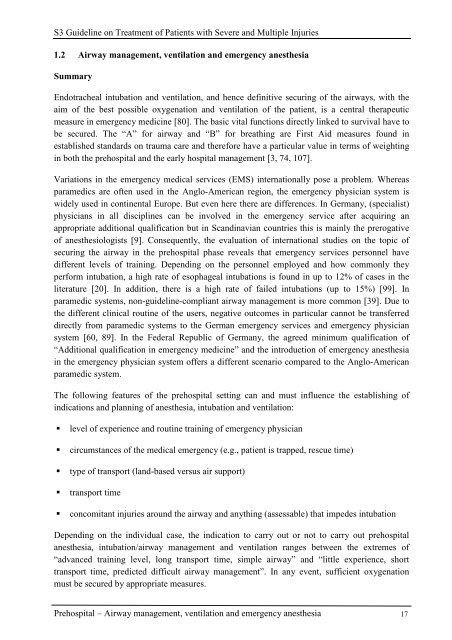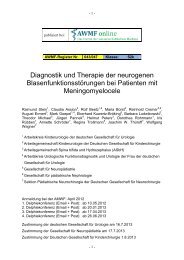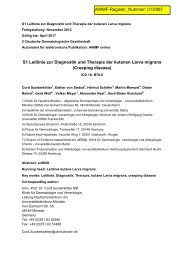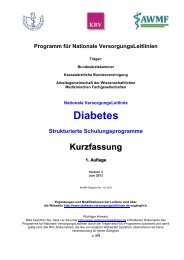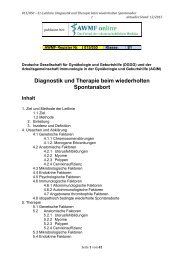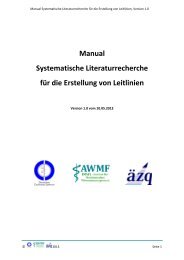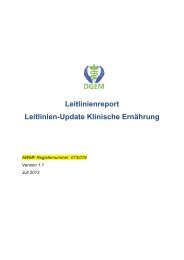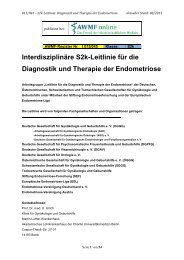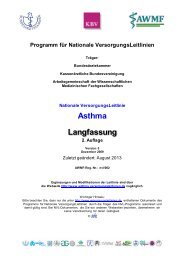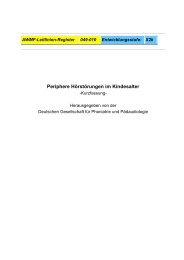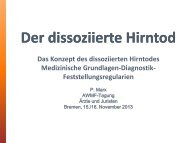Guideline on Treatment of Patients with Severe and Multiple ... - AWMF
Guideline on Treatment of Patients with Severe and Multiple ... - AWMF
Guideline on Treatment of Patients with Severe and Multiple ... - AWMF
You also want an ePaper? Increase the reach of your titles
YUMPU automatically turns print PDFs into web optimized ePapers that Google loves.
S3 <str<strong>on</strong>g>Guideline</str<strong>on</strong>g> <strong>on</strong> <strong>Treatment</strong> <strong>of</strong> <strong>Patients</strong> <strong>with</strong> <strong>Severe</strong> <strong>and</strong> <strong>Multiple</strong> Injuries<br />
1.2 Airway management, ventilati<strong>on</strong> <strong>and</strong> emergency anesthesia<br />
Summary<br />
Endotracheal intubati<strong>on</strong> <strong>and</strong> ventilati<strong>on</strong>, <strong>and</strong> hence definitive securing <strong>of</strong> the airways, <strong>with</strong> the<br />
aim <strong>of</strong> the best possible oxygenati<strong>on</strong> <strong>and</strong> ventilati<strong>on</strong> <strong>of</strong> the patient, is a central therapeutic<br />
measure in emergency medicine [80]. The basic vital functi<strong>on</strong>s directly linked to survival have to<br />
be secured. The “A” for airway <strong>and</strong> “B” for breathing are First Aid measures found in<br />
established st<strong>and</strong>ards <strong>on</strong> trauma care <strong>and</strong> therefore have a particular value in terms <strong>of</strong> weighting<br />
in both the prehospital <strong>and</strong> the early hospital management [3, 74, 107].<br />
Variati<strong>on</strong>s in the emergency medical services (EMS) internati<strong>on</strong>ally pose a problem. Whereas<br />
paramedics are <strong>of</strong>ten used in the Anglo-American regi<strong>on</strong>, the emergency physician system is<br />
widely used in c<strong>on</strong>tinental Europe. But even here there are differences. In Germany, (specialist)<br />
physicians in all disciplines can be involved in the emergency service after acquiring an<br />
appropriate additi<strong>on</strong>al qualificati<strong>on</strong> but in Sc<strong>and</strong>inavian countries this is mainly the prerogative<br />
<strong>of</strong> anesthesiologists [9]. C<strong>on</strong>sequently, the evaluati<strong>on</strong> <strong>of</strong> internati<strong>on</strong>al studies <strong>on</strong> the topic <strong>of</strong><br />
securing the airway in the prehospital phase reveals that emergency services pers<strong>on</strong>nel have<br />
different levels <strong>of</strong> training. Depending <strong>on</strong> the pers<strong>on</strong>nel employed <strong>and</strong> how comm<strong>on</strong>ly they<br />
perform intubati<strong>on</strong>, a high rate <strong>of</strong> esophageal intubati<strong>on</strong>s is found in up to 12% <strong>of</strong> cases in the<br />
literature [20]. In additi<strong>on</strong>, there is a high rate <strong>of</strong> failed intubati<strong>on</strong>s (up to 15%) [99]. In<br />
paramedic systems, n<strong>on</strong>-guideline-compliant airway management is more comm<strong>on</strong> [39]. Due to<br />
the different clinical routine <strong>of</strong> the users, negative outcomes in particular cannot be transferred<br />
directly from paramedic systems to the German emergency services <strong>and</strong> emergency physician<br />
system [60, 89]. In the Federal Republic <strong>of</strong> Germany, the agreed minimum qualificati<strong>on</strong> <strong>of</strong><br />
“Additi<strong>on</strong>al qualificati<strong>on</strong> in emergency medicine” <strong>and</strong> the introducti<strong>on</strong> <strong>of</strong> emergency anesthesia<br />
in the emergency physician system <strong>of</strong>fers a different scenario compared to the Anglo-American<br />
paramedic system.<br />
The following features <strong>of</strong> the prehospital setting can <strong>and</strong> must influence the establishing <strong>of</strong><br />
indicati<strong>on</strong>s <strong>and</strong> planning <strong>of</strong> anesthesia, intubati<strong>on</strong> <strong>and</strong> ventilati<strong>on</strong>:<br />
� level <strong>of</strong> experience <strong>and</strong> routine training <strong>of</strong> emergency physician<br />
� circumstances <strong>of</strong> the medical emergency (e.g., patient is trapped, rescue time)<br />
� type <strong>of</strong> transport (l<strong>and</strong>-based versus air support)<br />
� transport time<br />
� c<strong>on</strong>comitant injuries around the airway <strong>and</strong> anything (assessable) that impedes intubati<strong>on</strong><br />
Depending <strong>on</strong> the individual case, the indicati<strong>on</strong> to carry out or not to carry out prehospital<br />
anesthesia, intubati<strong>on</strong>/airway management <strong>and</strong> ventilati<strong>on</strong> ranges between the extremes <strong>of</strong><br />
“advanced training level, l<strong>on</strong>g transport time, simple airway” <strong>and</strong> “little experience, short<br />
transport time, predicted difficult airway management”. In any event, sufficient oxygenati<strong>on</strong><br />
must be secured by appropriate measures.<br />
Prehospital – Airway management, ventilati<strong>on</strong> <strong>and</strong> emergency anesthesia 17


